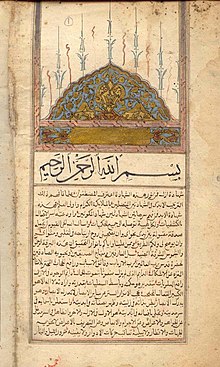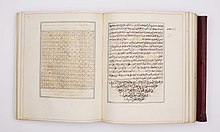Shams al-Ma'arif
 From Wikipedia the free encyclopedia
From Wikipedia the free encyclopedia
 The introduction of the Book A manuscript copy, beginning of 17th century | |
| Author | Ahmad al-Buni Almalki |
|---|---|
| Language | Arabic |
| Genre | Occult treatise, Grimoire |
| OCLC | 20121408 |
| LC Class | BF1771 .B8 Arab |
Shams al-Ma'arif or Shams al-Ma'arif wa Lata'if al-'Awarif[a] is a 13th-century grimoire centered on Arabic magic and claimed to be a manual for achieving esoteric spirituality. It was written by the scholar Ahmad al-Buni who wrote it while living in Algeria; he died around 1225 CE (622 AH).[1] The book is a patchwork of bits and pieces of al-Buni's authentic works, and texts by other authors.[2] Scholars like the proto-Salafi ibn Taymiyya have criticized the book and labeled al-Buni as a deluded devil worshipper.[3][4][relevant?]
In contemporary form, the book consists of two volumes, Shams al-Ma'arif al-Kubra[b] and Shams al-Ma'arif al-Sughra,[c] the former being the larger of the two.[5][6] The first few chapters introduce the reader to magic squares, and the combination of numbers and the alphabet that are believed to bring magical effect, which the author claims is the only way to communicate with jinn, angels and spirits. The table of contents that was introduced in the later printed editions of the work contains a list of unnumbered chapters (faṣl), which stretch to 40. However, before the printing press and various other standardisations, there were three independent volumes that circulated, each one differing in length.[7]
While being popular, it also carries a notorious reputation for being suppressed and banned for much of Islamic history.[8] However, it continues to persist, in being read and studied up to the present day, despite its questionable veracity and negative implications.[9][10] Some Sufi orders, such as the Naqshbandi-Haqqani order have occasionally recognised its potential spiritual value, provided that the reader understands it.[11]
Another title by the same author, namely Manba' Usul al-Hikmah "The Source of the Essentials of Wisdom", is considered its companion text.
Translations[edit]

Although a translation into English has not been undertaken, there have been numerous renditions of a few of the more popular rituals found within the main treatise, as well as those that lie in its accompanying text. Some of these rituals have had various degrees of notability, but one of recurring presence in many publications is that of the Birhatiya[12][13][14] (also known as The Ancient Oath or Red Sulphur[15]).
In 2022 a partial English translation by Amina Inloes was published by Revelore Press as "Shams al-Ma’arif: The Sun of Knowledge An Arabic Grimoire: A selected Translation"[16]
In 2023 another English translation of the Shams al Ma'arif was published by Johann Voldemont as ''Shams al-Ma'arif:Talismans and Magic Squares'' which focuses primarily on the talismans and magic squares contained within the text.[17] Outside of the Arab and Western world, several editions of the book have been published in the Urdu and Turkish languages.[18][19][20]
See also[edit]
Notes[edit]
- ^ Owen Davies, Grimoires: A History of Magic Books, Oxford University Press, 2009, p. 27
- ^ Gardiner, Noah (2012), Forbidden Knowledge? Notes on the production, transmission, and reception of the major works of Ahmad al-Buni, Journal of Arabic and Islamic Studies 12 (2012). University of Michigan.
- ^ Gardiner, Noah (2017), Esotericist Reading Communities and the Early Circulation of the Sufi Occultist Aḥmad al-Būnī’s Works, Arabica 64 (2017) 405-441. Brill.
- ^ "Narratives of Danger: The Sun of Knowledge in Arabic Occulture". Leidenislamblog. June 30, 2022. Retrieved June 1, 2023.
- ^ Shamsu al-Ma‘aref al-Kubrah, Al Nour Library, Beirut, Lebanon: 2006.
- ^ Shamsu al-Ma‘aref al-Sughra, Al Nour Library, Beirut, Lebanon: 2005.
- ^ Francis Maddison, Emilie Savage-Smith, Ralph H. Pinder-Wilson, Tim Stanley, Science, Tools And Magic Vol. 12, Oxford University Press, 1997, p. 65
- ^ Michael Ipgrave, Scriptures in Dialogue: Christians and Muslims Studying the Bible and the Qur'an Together, Church Publishing Inc, 2004, p. 42
- ^ Gardiner, Noah (2017), Esotericist Reading Communities and the Early Circulation of the Sufi Occultist Aḥmad al-Būnī’s Works, Arabica 64 (2017) 405-441. Brill.
- ^ "Narratives of Danger: The Sun of Knowledge in Arabic Occulture". Leidenislamblog. June 30, 2022. Retrieved June 1, 2023.
- ^ "Shamsu'l-Ma'arif". eshaykh.com. Archived from the original on October 23, 2011. Retrieved July 9, 2011.
- ^ Wahid Azal, The Birhatiya Conjuration Oath & the meaning of its first 28 names, N.U.R.-Fatimiya Sufi Order, 2008
- ^ Nineveh Shadrach, Magic That Works: Practical Training for the Children of Light, Ishtar Publishing, 2005, p. 228
- ^ Nineveh Shadrach, Ancient Magick Conjuration of Power: Beginners Guide to the Berhatiah, Ishtar Publishing, 2011
- ^ Nineveh Shadrach, Magic That Works: Practical Training for the Children of Light, Ishtar Publishing, 2005, p. 48
- ^ "Shams al-Ma'arif (The Sun of Knowledge)".
- ^ Shams al-Ma'arif:Talismans and Magic Squares. Independently published. 2023. ISBN 979-8-8626-1047-5.
- ^ Iqbal al-Din Ahmad, Shams al-Ma'arif al-Kubra Wa Lata'if al-'Awarif. Urdu, Darul Ishaat, Karachi, Pakistan: 1978.
- ^ Basir Ahmad Hadrat Kalianwala, Shams al-Ma'arif Lata'if al-'Awarif. Urdu Tarjama, Kutub Khana Shan-e-Islam, Lahore, Pakistan.
- ^ Selahattin Alpay, Sems’ül Maarif. Büyük Bilgiler Güneşi, P.K. 157 Beyazid, Istanbul: 1979.